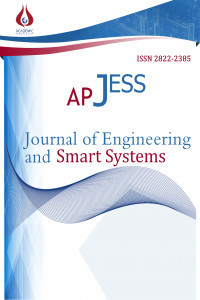The influence of particle size on efficiency of quartz flotation
Quartz, Beneficiation, Particle size, Flotation
___
- 1. Quartz Silica Group of Silicate Minerals. University of Minnesota, Retrieved 5th December 2018. https://www.esci.umn.edu/courses/1001/minerals/quartz.shtml
- 2. E.D. Martello, Impurity distribution and reduction behaviour of quartz in the production of high purity silicon. Thesis for the degree of Philosophiae Doctor. Norwegian University of Science and Technology, Norwey, 2012.
- 3. J.E. Kogel, N. Trivedi, J.M. Barker, S.T. Krukowski, Industrial Minerals & Rocks – Commodities, Markets and Uses, Society for Mining, Metallurgy and Exploration Inc. Englewood, U.K, 2006.
- 4. M. Gemeinert, M. Gaber, I. Hager, M. Willhfahrt, D. Bortschuloun. On correlation of Gas-Liquid inclusion's Properties and Melting Behaviour of Different Genetic Quartzes for Production of Transparent fused Silica. Neues Jahrbuch Miner. Abh. 165, 19-27, 1992.
- 5. U. Andres, J, Jirestig, Timoshkin Liberation of minerals by highvoltage electrical pulses. Powder Tehcnol 104, 37-49,1999.
- 6. F. Göktepe, H. Ipek, M. Göktepe. Beneficiation of quartz waste by flotation and by ultrasonic treatment. Physicochem. Probl. Miner. Process. 47, 41-50, 2011.
- 7. J. Qu, X. Tao, L. Tang, N. Xu, H. He. Flotation characteristics and particle size distribution of micro-fine low rank coal. Procedia Engineering 102, 159-166, 2015.
- 8. Y.F. Li, W.D. Zhao, X.H. Gui, X.B. Zhang, Flotation kinetics and separation selectivity of coal size fractions, Physicochem. Probl. Miner.Process. 49, 387-395, 2013.
- 9. X.H. Gui, J.T. Liu, X.X. Tao, Y.T. Wang, Y.J. Cao, Studies on flotation rate of a hard to float fine coal, J. China Coal Soc. 36, 895-1900, 2011. (in Chinese).
- 10. W.C. Xia, J.G. Yang, B. Zhu, The improvement of grindability and floatability of oxidized coal by microwave pre-treatment, Energy Source Part A, 36, 23-30, 2014.
- 11. S. Zhong, F. Baitalow, P. Nikrityuk, H. Gutte, B. Meyer, The effect of particle size on the strength parameters of German brown coal and its chars, Fuel, 125, 200-205, 2014.
- 12. F. Boylu, H. Dincer, G. Ateşok, Effect of coal particle size distribution, volume fraction and rank on the rheology of coal–water slurries, Fuel Process. Technol. 85, 241-250, 2004.
- 13. R. H. Urbina, Recent developments and advances in formulations and applications of chemical reagents used in froth flotation. Mineral Processing & Extractive Metall. Rev, 24, 139 182, 2003.
- 14. R.D. Kulkarni and P. Somasundaran. Flotation chemistry of hematite/oleat system. Colloids and Surfaces. 1, 387-405, 1980.
- 15. Ö.Y. Gülsoy and F. Kılavuz, The Use of Na-Oleate with metal salts as a Collector in K-Feldspar Quartz Flotation. Madencilik, 22-34, 2002. (in Turkish).
- 16. H. Wotruba, H. Hoberg, FU. Schneider. XVIIth Int Miner ProcessCong IV. 83–95, 1991.
- 17. N. Vlachos, I.T.H. Chang. Graphical and statistical comparison of various size distribution measurement systems using metal powders of a range of sizes and shapes. Powder Metallurgy. 54, 497-506, 2011.
- Yayın Aralığı: Yılda 3 Sayı
- Başlangıç: 2022
- Yayıncı: Akademik Perspektif Derneği
Zeolit İkameli Geopolimer Betonlarda Kür Şartlarının Etkileri
The influence of particle size on efficiency of quartz flotation
Hüsnügül YILMAZ ATAY, Mustafa ÇIRAK
Çok Katlı Betonarme Binalarda 2018 Deprem Yönetmeliği İle Tanımlanan Spektrum Eğrilerinin Etkisi
Ahu ÇELEBİ, Halil TOSUN, Ali Çağlar ÖNÇAĞ
Türkiye’de Dijital Dönüşüme Başlangıç için AHP ve TOPSIS Yöntemleri ile Sektörel Sıralama
Ayten YILMAZ YALCINER, İrem ÇAYLAK
Betonarme Bir Çerçevenin Farklı Yerleşim Düzenlerine Sahip Merkezi Çelik Çaprazlarla Güçlendirilmesi
